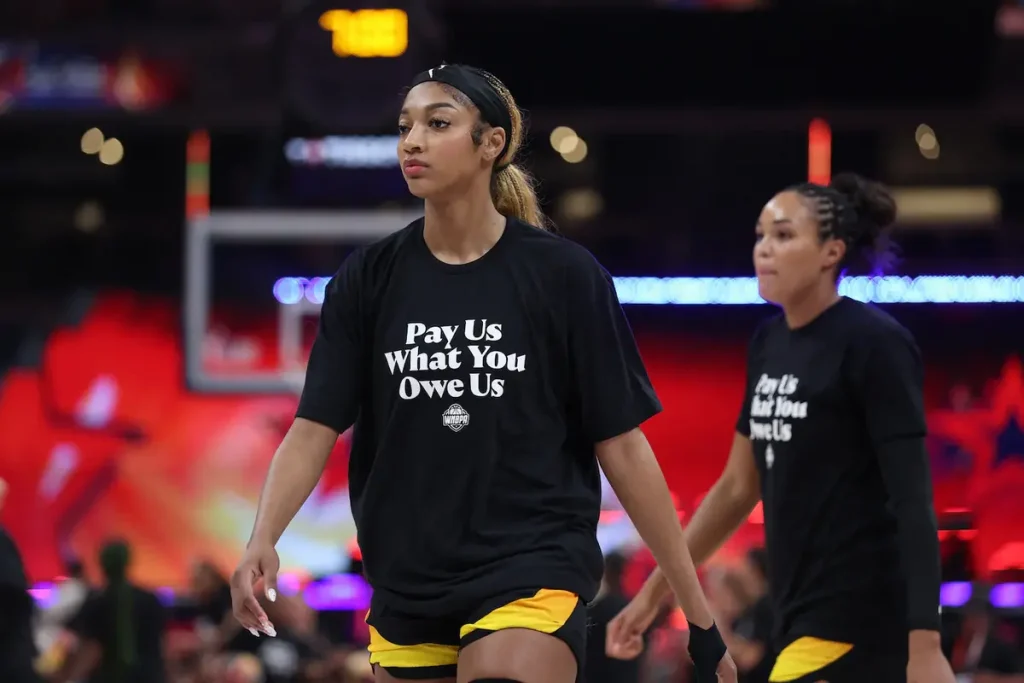At the 2025 WNBA All-Star Game in Indianapolis, players took center stage off the court. Nearly 40 All-Stars—including stars like Caitlin Clark, Sabrina Ionescu, and Napheesa Collier—wore black warmup shirts declaring “Pay Us What You Owe Us.” This unified action spotlighted their frustration over contentious CBA (Collective Bargaining Agreement) negotiations, set to expire on October 31, 2025.
The WNBA “Pay Us What You Owe Us” Movement Explained
Despite rapid growth—including a pending $2.2 billion media rights deal starting in 2026 and soaring $250 million expansion fees—players say their compensation doesn’t reflect the league’s success. Fans loudly chanted “Pay them!” during Commissioner Cathy Engelbert’s speech, and MVP Napheesa Collier captured the moment by holding up a sign that read “Pay The Players.”.
What Are the Players Asking For?
Key demands include:
-
Revenue-sharing reform: Players seek a deal similar to the NBA’s ~50% revenue split model; currently, WNBA players receive less than 10%.
-
Salary increases and better benefits: As league revenues grow, players want pay, health care, and maternity leave to reflect modern realities.
-
Expanded revenue pool: Only ~40% of league revenue is allocated to teams and players; NBA and investors control ~60%.
WNBPA President Nneka Ogwumike stressed that while viewership, merchandising, and ticket sales rise, players are still underpaid relative to their contributions.
Financial Reality: The WNBA Still Operate At A Loss!
Despite the growing popularity, the WNBA has never turned a profit. Since its founding in 1997, the league has lost more than $10 million per year on average, totaling roughly $280 million by 2018. In 2024, losses surged to an estimated $50 million despite record-breaking ticket sales, merch growth, and rising viewership.
NBA Commissioner Adam Silver confirmed the WNBA operates at a loss, and the league relies heavily on NBA subsidies and external investments to stay afloat. Even as revenue approaches $200 million annually, the league continues to operate in the red to fund expenses such as $25 million in charter flight costs and expansion infrastructure.
Commissioner Engelbert defended the ongoing negotiations, calling them “constructive” and expressing optimism for a “transformational deal” before the CBA deadline. She acknowledged balancing player demands with the league’s long-standing financial deficits.
However, players criticized the league for slow responses and inadequate offers—after the players opted out of the previous CBA, the league took nearly five months to respond with a proposal many considered insufficient.
The WNBA is in the midst of a cultural renaissance. Stars like Caitlin Clark and Angel Reese have ignited passion for women’s basketball, while teams like the Liberty have sold out games in major arenas. New expansion cities—Portland, Toronto, Cleveland—signal rising valuation.
Yet, the league’s growth hasn’t translated into profitability. Players argue that unless revenue is shared more fairly, it’s unsustainable to build equitable pay. Critics argue that holding out for better deals is critical for long-term sustainability.
With the October deadline approaching, a potential lockout or strike looms large. Over 80% of players will become free agents—raising urgency amid hopes for raised roster sizes, better health benefits, and expanded compensation structures. If talks stall, 2026’s season, draft, and expansion plans could face disruption.
Fans, sponsors, and media all watch closely: will the WNBA continue to fight for its players or follow a top-down status quo?
The “Pay Us What You Owe Us” movement at the 2025 WNBA All-Star Game represents more than a fashion statement—it’s a powerful demand for recognition in a league that has yet to turn a profit. As the players push for financial justice, their impact extends beyond the court: the future of women’s professional basketball is on the line, and this negotiation may reshape it forever.


